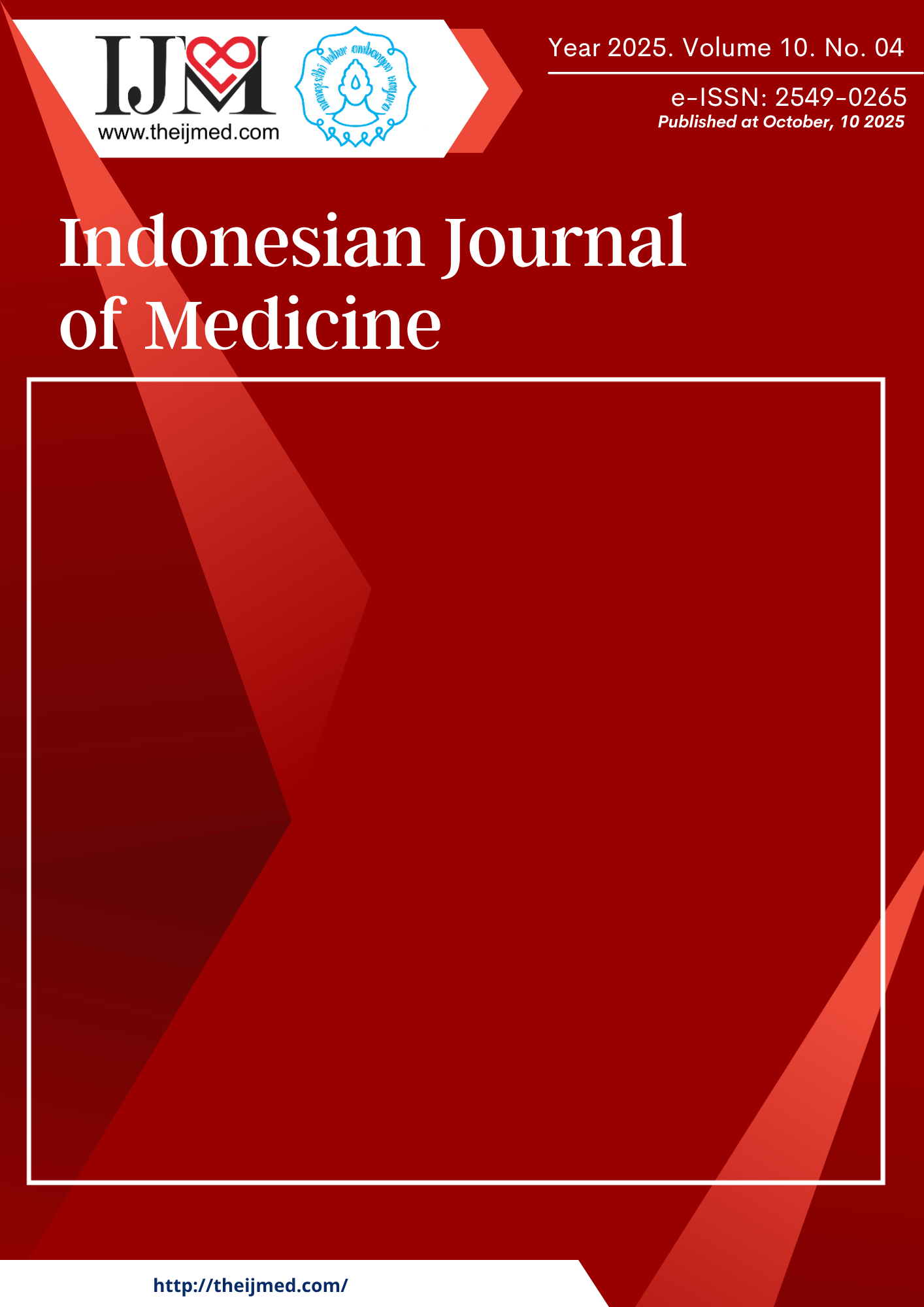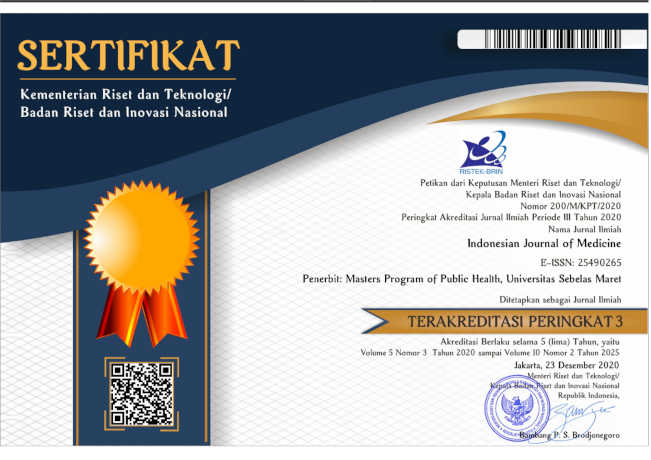Older Adults Exhibit a Nine-Fold Increased Risk of Type 2 Diabetes Mellitus: Evidence from a Hospital-Based Cross-Sectional Analysis
DOI:
https://doi.org/10.26911/theijmed.2025.10.4.873Abstract
Background: Type 2 diabetes mellitus represents a significant global health burden with increasing prevalence worldwide. Age and gender are recognized as important demographic risk factors influencing diabetes incidence. This study aimed to determine the relationship between age and gender with the incidence rate of type 2 diabetes mellitus at Bhayangkara Pusdik Brimob Watukosek Hospital.
Subjects and Method: This cross-sectional study conducted at internal medicine polyclinic, Bhayangkara Pusdik Brimob Watukosek Hospital, Pasuruan, East Java, Indonesia, from October 2020 to May 2021. Study subjects of 250 patients were selected using total sampling technique. Secondary data from medical records were analyzed using odds ratio calculations to determine associations between age (categorized as high-risk ≥45 years vs low-risk <45 years) and gender with type 2 diabetes mellitus incidence. Data were analyzed using a multiple logistic regression.
Results: Among 250 respondents, 140 (56.00%) were diagnosed with type 2 diabetes mellitus. High-risk age group comprised 136 respondents (54.40%), with 107 (76.40%) having diabetes. Female respondents totaled 148 (59.20%), with 80 (57.10%) having diabetes. Age demonstrated significant association with diabetes incidence (OR= 9.06; 95% CI= 5.15 to 15.93; p<0.001), indicating that high-risk age individuals were nine times more likely to develop diabetes compared to low-risk age individuals. Gender showed no significant association with diabetes incidence (OR= 0.82; 95% CI= 0.48 to 1.41; p=0.475).
Conclusion: Age has a significant relationship with type 2 diabetes mellitus, while gender shows no significant association.
Keywords:
Age, gender, cross-sectional study, type 2 diabetes mellitus, Age, gender, cross-sectional study, type 2 diabetes mellitusReferences
Bellary S, Kyrou I, Brown JE, Bailey CJ (2021). Type 2 diabetes mellitus in older adults: clinical considerations and management. Nat Rev Endo-crinol. 17(9): 534–548. doi: 10.10-38/s41574-021-00512-2.
Bellou V, Belbasis L, Tsafantakis E, Evangelou E (2018). Risk factors for type 2 diabetes mellitus: an exposure-wide umbrella review of meta-analyses. PLoS One. 13(3): e0194127. doi: 10.1371/journal.-pone.0194127.
Chia CW, Egan JM, Ferrucci L (2018). Age-related changes in glucose meta-bolism, hyperglycemia, and cardiovascular risk. Circ Res. 123(7): 886–904. doi: 10.1161/-CIRCRESAHA.118.312806.
Eizirik DL, Pasquali L, Cnop M (2020). Pancreatic β-cells in type 1 and type 2 diabetes mellitus: different pathways to failure. Nat Rev Endocrinol. 16(7): 349–362. doi: 10.1038/s41574-020-0355-7
ElSayed NA, Aleppo G, Bannuru RR, Bruemmer D, Collins BS, Ekhlaspour L, Gaglia JL, et al. (2024). Diagnosis and classification of diabetes: standards of care in diabetes 2024. Diabetes Care. 47(1): S20–S42. doi: 10.2337/dc24-S002
ElSayed NA, Aleppo G, Bannuru RR, Bruemmer D, Collins BS, Ekhlaspour L, Galindo RJ, et al. (2024). Diabetes care in the hospital: standards of care in diabetes 2024. Diabetes Care. 47(1): S295–s306. doi: 10.2337/dc24-S016.
Elshaikh U, Eltayeb R, Subahi M, Bashir A (2024). The associated risk factors for type 2 diabetes mellitus among adults: a cross-sectional study using electronic medical records in the Primary Health Care Corporation, Qatar. Discov Health Syst. 3(1): 70. doi: 10.1007/s44250-024-00134-1.
Huebschmann AG, Huxley RR, Kohrt WM, Zeitler P, Regensteiner JG, Reusch JEB (2019). Sex differences in the burden of type 2 diabetes and cardio-vascular risk across the life course. Diabetologia. 62(10): 1761–1772. doi: 10.1007/s00125-019-4939-5.
Kautzky-Willer A, Leutner M, Harreiter J (2023). Sex differences in type 2 diabetes. Diabetologia. 66(6): 986–1002. doi: 10.1007/s00125-023-058-91-x.
Khin PP, Lee JH, Jun HS (2023). Pancre-atic beta-cell dysfunction in type 2 diabetes. Eur J Inflamm. 21: 17217-27X231154152. doi: 10.1177/1721727-X231154152.
Liu C, Wang C, Guan S, Liu H, Li X, Zhang Z, Gu X, et al. (2020). A cross-sectio-nal study on diabetes epidemiology among people aged 40 years and above in Shenyang, China. Sci Rep. 10(1): 17742. doi: 10.1038/s41598-020-74889-x
Ong KL, Stafford LK, McLaughlin SA, Boyko EJ, Vollset SE, Smith AE, Dalton BE, et al. (2023). Global, regional, and national burden of diabetes from 1990 to 2021, with projections of prevalence to 2050: a systematic analysis for the Global Burden of Disease Study 2021. Lancet. 402(10397): 203–234. doi: 10.1016/S0140-6736(23)01301-6.
Petersen MC, Shulman GI (2018). Mecha-nisms of insulin action and insulin resistance. Physiol Rev. 98(4): 2133–2223. Doi: 10.1152/physrev.00063.2-017.
Setia M (2016). Methodology series module 3: cross-sectional studies. Indian J Dermatol. 61(3): 261. doi: 10.4103/0019-5154.182410.
Sun H, Saeedi P, Karuranga S, Pinkepank M, Ogurtsova K, Duncan BB, Stein C, et al. (2022). IDF diabetes atlas: global, regional and country-level diabetes prevalence estimates for 2021 and projections for 2045. Dia-betes Res Clin Pract. 183: 109119. doi: 10.1016/j.diabres.2021.109119.
Tramunt B, Smati S, Grandgeorge N, Lenfant F, Arnal JF, Montagner A, Gourdy P (2020). Sex differences in metabolic regulation and diabetes susceptibility. Diabetologia. 63(3): 453–461. doi: 10.1007/s00125-019-05040-3.
Troncone A, Cascella C, Chianese A, Galiero E, Piscopo A, Cascella C, Zanfardino A, et al. (2020). Body image problems and disordered eating behaviors in Italian adolescents with and without type 1 diabetes: an examination with a gender-specific body image measure. Front Psychol. 11: 556520. doi: 10.3-389/fpsyg.2020.556520.
Wahidin M, Adisasmito W, Ng N, Alwi Q, Amelia R, Riono P (2024). Projection of diabetes morbidity and mortality till 2045 in Indonesia based on risk factors and NCD prevention and control programs. Sci Rep. 14(1): 5424. doi: 10.1038/s41598-024-545-63-2.
Wang Y, O'Neil A, Jiao Y, Wang L, Huang J, Lan Y, Tong M, et al. (2019). Sex differences in the association between diabetes and risk of cardiovascular disease, cancer, and all-cause and cause-specific mortal-ity: a systematic review and meta-analysis of 5,162,654 participants. BMC Med. 17(1): 136. doi: 10.1186/-s12916-019-1355-0.
Zhao X, An X, Yang C, Sun W, Ji H, Lian F (2023). The crucial role and mecha-nism of insulin resistance in meta-bolic disease. Front Endocrinol. 14: 1149239. doi: 10.3389/fendo.2023.-1149239.
Zheng Y, Ley SH, Hu FB (2018). Global aetiology and epidemiology of type 2 diabetes mellitus and its compli-cations. Nat Rev Endocrinol. 14(2): 88–98. doi: 10.1038/nrendo.2017-.151.











